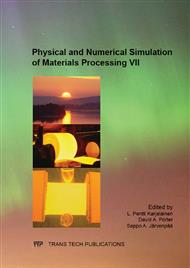[1]
H. Tersing, et al., Simulation of manufacturing chain of a titanium aerospace component with experimental validation. Finite Elements in Analysis and Design 51 (2012) 10-21.
DOI: 10.1016/j.finel.2011.10.002
Google Scholar
[2]
J. McDill, A. Oddy, and M. Klein. Data transfer for 3-D adaptive thermal-elasto-plastic finite element analysis in NUMIFORM'95. 1995. Ithaca, USA.
Google Scholar
[3]
M. Ashby, Physical modelling of material problems. Mater. Sci. Techn. 8 (1992) 102-111.
Google Scholar
[4]
T. Johnston and C. Feltner, Grain size effects in the strain hardening of polycrystals. Metall. Mater. Trans. B 1 (1970) 1161-1167.
DOI: 10.1007/bf02900226
Google Scholar
[5]
Y. Bergström, The plastic deformation of metals - A dislocation model and its applicability. Reviews on powder metallurgy and physical ceramics. 2/3 (1983) 79-265.
Google Scholar
[6]
Y. Estrin, et al., Dislocation based gradient plasticity model. Journal De Physique. IV : JP. 8 (1998) 135-141.
Google Scholar
[7]
H. Mecking and U.F. Kocks, Kinetics of flow and strain-hardening. Acta Metall. 29 (1981) 1865-1875.
DOI: 10.1016/0001-6160(81)90112-7
Google Scholar
[8]
J. Bouquerel, K. Verbeken, and B.C. De Cooman, Microstructure-based model for the static mechanical behaviour of multiphase steels. Acta Mater. 54 (2006) 1443-1456.
DOI: 10.1016/j.actamat.2006.04.001
Google Scholar
[9]
E. Arzt, Size effects in materials due to microstructural and dimensional constraints: a comparative review. Acta Mater. 46 (1998) 5611-5626.
DOI: 10.1016/s1359-6454(98)00231-6
Google Scholar
[10]
G. Engberg and L. Lissel, A physically based microstructure model for predicting the microstructural evolution of a C-Mn steel during and after hot deformation. Steel Res. Int. 79 (2008) 47-58.
DOI: 10.1002/srin.200806315
Google Scholar
[11]
H.J. Frost and M.F. Ashby, Deformation-Mechanism Maps - The Plasticity and Creep of Metals and Ceramics, Pergamon Press, 1982.
Google Scholar


